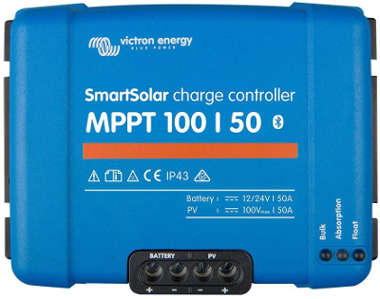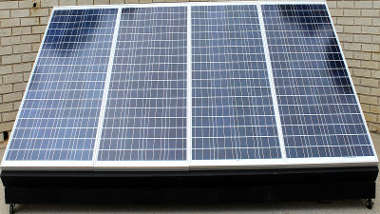![]() MPPT, Maximum Power Point Tracking, is a technology that attempts to get the maximum available power from solar panels by making them operate at the most efficient voltage.
An MPPT charge controller is a true DC to DC voltage converter. With PWM (Pulse-width Modulation) charge controllers, the input voltage from the solar array will be pulled
down to the voltage of the battery bank, in the case of most RV systems; 12 Volts.
MPPT, Maximum Power Point Tracking, is a technology that attempts to get the maximum available power from solar panels by making them operate at the most efficient voltage.
An MPPT charge controller is a true DC to DC voltage converter. With PWM (Pulse-width Modulation) charge controllers, the input voltage from the solar array will be pulled
down to the voltage of the battery bank, in the case of most RV systems; 12 Volts.
![]() I built a Portable Solar Power System with four 120 Watt panels that can only achieve 120 Watt per panel at approximately 17.1 Volts. (pictured to the right) Most RV battery
banks operate at 12 Volts so a PWM charge controller would limit the input voltage to the charge controller to the voltage of the barrery bank. (12 volts) This will artificially
limit the 120 Watt panel's charging potential to approximately 71 Watts under the best of conditions! No Good!
I built a Portable Solar Power System with four 120 Watt panels that can only achieve 120 Watt per panel at approximately 17.1 Volts. (pictured to the right) Most RV battery
banks operate at 12 Volts so a PWM charge controller would limit the input voltage to the charge controller to the voltage of the barrery bank. (12 volts) This will artificially
limit the 120 Watt panel's charging potential to approximately 71 Watts under the best of conditions! No Good!
![]() An MPPT charge controller will resolve the voltage differential internally by outputting the 12 Volts expected by the battery bank while raising the current (AMPS) to nearly 40 AMPS.
(With this four panel array) This will achieve the 120 Watts expected from each panel. (Under Perfect Conditions of course) MPPT charge controllers are more expensive but well worth the
cost considering the hiden power loss of PWM controllers. Some suggest simply adding more panels to compensate for PWM loss. I suggest installing an MPPT charge controller. Period.
An MPPT charge controller will resolve the voltage differential internally by outputting the 12 Volts expected by the battery bank while raising the current (AMPS) to nearly 40 AMPS.
(With this four panel array) This will achieve the 120 Watts expected from each panel. (Under Perfect Conditions of course) MPPT charge controllers are more expensive but well worth the
cost considering the hiden power loss of PWM controllers. Some suggest simply adding more panels to compensate for PWM loss. I suggest installing an MPPT charge controller. Period.

